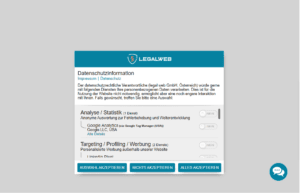Use Search History GDPR compliant. Follow these instructions:
Services & integrations
Back
The GDPR compliant use of Search History
First of all, we have to clarify whether consent is required in order to integrate Search History GDPR compliant.
Due to the fact that the integration of Search History is not necessary for the operation of the website, the integration requires consent.
With the use of Search History, no data is passed on, so there is no additional information about data recipients in the data protection declaration.
1. Obtain explicit consent for Search History from users by opt-in
Before Search History becomes active on the website and begins to collect user data, the user must first give their explicit consent. If the user refuses to consent, which must also be possible - Search History must not be activated. No data is allowed to be forwarded to the 3rd party. This opt-in procedure is mandatory in order to comply with data protection regulations.
2. Always offer the option to revoke the consent (opt-out) for Search History
Even if the user has agreed to the use of Search History, he or she must still be given the opportunity to reverse this decision and deactivate tracking at any time. For this reason, it is necessary to provide an opt-out procedure that is easy for the website visitor to access at any time. The user must be able to revoke his consent. The option to revoke must be just as easy as the option to consent.
3. Mention Search History in the privacy policy completely, simply and transparently
The privacy policy on your website must be comprehensive, transparent and accurate. It should be readable and understandable by anyone, even without legal training. It is important to include a section on Search History that clearly describes what data is collected, for what purpose it is used and who is responsible for it, as well as whether data is shared and what legal basis applies.
Privacy Statement for the Service Search HistoryAdditional data is processed when you use certain sub-services on our website. Locations selected in the search, such as stations, addresses or points of interest (POIs), are saved on your device. If you have given your consent, the locations you have searched for most recently will be processed so that you can quickly find the start and finish destinations you entered in the search function. The legal basis for this data processing is your consent, in accordance with Art. 6 para. 1 lit. a GDPR. You can withdraw your consent via the cookie settings. This data will be deleted after 365 days. If you do not give your consent, we will not be able to display any searches you have already performed. Processed data categories: data about your inquiry or contact. Purpose of processing: content optimization. The legal basis for processing: Your consent according to Art. 6 (1) a GDPR. 4. Additional Information for Search History and GDPR
In addition to the above information, the data protection information must also contain the mandatory information from Art. 13 or 14 GDPR: Name and contact details of the controller, if necessary the contact details of the data protection officer, the purposes for which the personal data are to be processed, the legitimate interests, if the processing is based on Article 6 (1) f GDPR, the duration of the processing, information on the rights of the data subjects including the right to lodge a complaint with a supervisory authority, the possibility of simply revoking consent given, and information as to whether the Provision of the data is required by law or contract or what the possible consequences of non-provision would be. In the event that the data is used for automated decision-making, including profiling, meaningful information about the logic involved and the scope and impact on the data subject must be provided. The processing of the data must also be documented in the list of processing activities in accordance with Art. 30 GDPR. The information required for this can already be found in the privacy statement, which can be created from the previous information.
5. Formulate the consent in an understandable manner and present it clearly. Do not use dark patterns.
Before the user agrees or rejects the use of Search History, he must be informed in detail about the respective purposes. Therefore, a precisely formulated consent text is of great importance. This should also be placed so that it is immediately recognizable for the user. The user's consent must be active. Individual services must not be preselected.
6. Use a Consent Management Provider CMP (cookie banner/cookie popup/cookie bar)
Different names, but usually the same purpose. CMP supports you with consent (opt-in and opt-out, data protection declaration and other GDPR topics. Technical support is recommended with regard to the GDPR and consent management in order to avoid errors.
Our consent tool for the use of Search History: Legal Web Privacy Cloud CMP





Legal Web Privacy Cloud supports you in the legally compliant integration of Search History. Our Consent Manager platform provides you with the following functions:
- Legally compliant cookie pop-up for opt-in and opt-out
- Complete privacy policy incl. purposes, data categories, recipients, …
- Correct imprint
- Automatic updates when laws change
With Legal Web Privacy Cloud we offer a All-in-one GDPR package for your website and webshop. Worry-free, legally compliant and always up to date with the latest legal bases and support for Search History.
Preconfigured services & integrations
Individually expandable